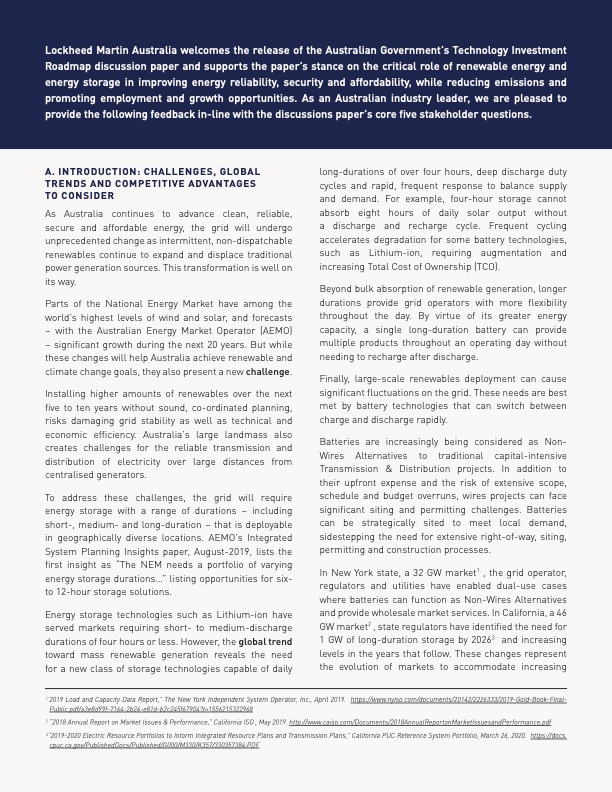
PDF Publication Title:
Text from PDF Page: 002
Lockheed Martin Australia welcomes the release of the Australian Government’s Technology Investment Roadmap discussion paper and supports the paper’s stance on the critical role of renewable energy and energy storage in improving energy reliability, security and affordability, while reducing emissions and promoting employment and growth opportunities. As an Australian industry leader, we are pleased to provide the following feedback in-line with the discussions paper’s core five stakeholder questions. A. INTRODUCTION: CHALLENGES, GLOBAL TRENDS AND COMPETITIVE ADVANTAGES TO CONSIDER As Australia continues to advance clean, reliable, secure and affordable energy, the grid will undergo unprecedented change as intermittent, non-dispatchable renewables continue to expand and displace traditional power generation sources. This transformation is well on its way. Parts of the National Energy Market have among the world’s highest levels of wind and solar, and forecasts – with the Australian Energy Market Operator (AEMO) – significant growth during the next 20 years. But while these changes will help Australia achieve renewable and climate change goals, they also present a new challenge. Installing higher amounts of renewables over the next five to ten years without sound, co-ordinated planning, risks damaging grid stability as well as technical and economic efficiency. Australia’s large landmass also creates challenges for the reliable transmission and distribution of electricity over large distances from centralised generators. To address these challenges, the grid will require energy storage with a range of durations – including short-, medium- and long-duration – that is deployable in geographically diverse locations. AEMO’s Integrated System Planning Insights paper, August-2019, lists the first insight as “The NEM needs a portfolio of varying energy storage durations...” listing opportunities for six- to 12-hour storage solutions. Energy storage technologies such as Lithium-ion have served markets requiring short- to medium-discharge durations of four hours or less. However, the global trend toward mass renewable generation reveals the need for a new class of storage technologies capable of daily long-durations of over four hours, deep discharge duty cycles and rapid, frequent response to balance supply and demand. For example, four-hour storage cannot absorb eight hours of daily solar output without a discharge and recharge cycle. Frequent cycling accelerates degradation for some battery technologies, such as Lithium-ion, requiring augmentation and increasing Total Cost of Ownership (TCO). Beyond bulk absorption of renewable generation, longer durations provide grid operators with more flexibility throughout the day. By virtue of its greater energy capacity, a single long-duration battery can provide multiple products throughout an operating day without needing to recharge after discharge. Finally, large-scale renewables deployment can cause significant fluctuations on the grid. These needs are best met by battery technologies that can switch between charge and discharge rapidly. Batteries are increasingly being considered as Non- Wires Alternatives to traditional capital-intensive Transmission & Distribution projects. In addition to their upfront expense and the risk of extensive scope, schedule and budget overruns, wires projects can face significant siting and permitting challenges. Batteries can be strategically sited to meet local demand, sidestepping the need for extensive right-of-way, siting, permitting and construction processes. In New York state, a 32 GW market1 , the grid operator, regulators and utilities have enabled dual-use cases where batteries can function as Non-Wires Alternatives and provide wholesale market services. In California, a 46 GW market2 , state regulators have identified the need for 1 GW of long-duration storage by 20263 and increasing levels in the years that follow. These changes represent the evolution of markets to accommodate increasing 1”2019 Load and Capacity Data Report,” The New York Independent System Operator, Inc., April 2019. https://www.nyiso.com/documents/20142/2226333/2019-Gold-Book-Final- Public.pdf/a3e8d99f-7164-2b24-e81d-b2c245f67904?t=1556215322968 2 “2018 Annual Report on Market Issues & Performance,” California ISO , May 2019. http://www.caiso.com/Documents/2018AnnualReportonMarketIssuesandPerformance.pdf 3“2019-2020 Electric Resource Portfolios to Inform Integrated Resource Plans and Transmission Plans,” California PUC Reference System Portfolio, March 26, 2020. https://docs. cpuc.ca.gov/PublishedDocs/Published/G000/M330/K357/330357384.PDFPDF Image | Long-Duration Energy Storage and Redox Flow Batteries

PDF Search Title:
Long-Duration Energy Storage and Redox Flow BatteriesOriginal File Name Searched:
energy-aus-response-brief.pdfDIY PDF Search: Google It | Yahoo | Bing
Salgenx Redox Flow Battery Technology: Salt water flow battery technology with low cost and great energy density that can be used for power storage and thermal storage. Let us de-risk your production using our license. Our aqueous flow battery is less cost than Tesla Megapack and available faster. Redox flow battery. No membrane needed like with Vanadium, or Bromine. Salgenx flow battery
| CONTACT TEL: 608-238-6001 Email: greg@salgenx.com | RSS | AMP |